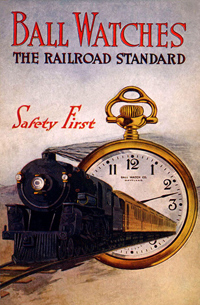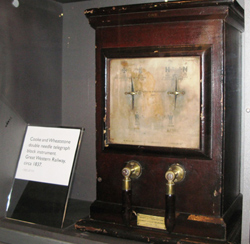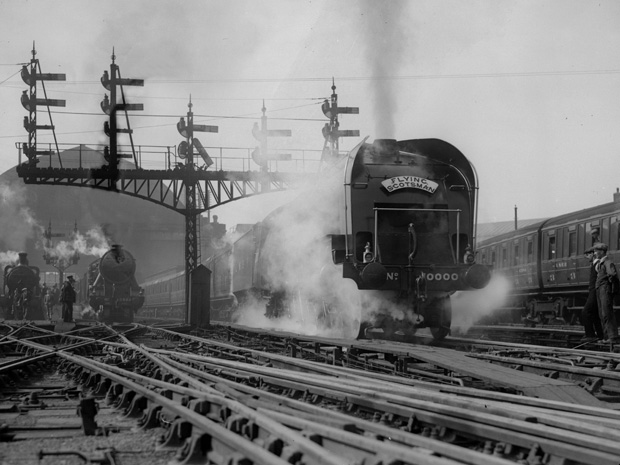 Ball watches became a railroad standard in 1891. Photo: Ball
Ball watches became a railroad standard in 1891. Photo: BallEngineers of the 1830s were faced with a critical dilemma: How do you send messages to control and direct trains when the trains themselves travel faster than messengers on foot or horseback, which were the fastest information carriers of the day? Compounding the problem was that the stopping distances of trains often exceeded a person’s line of sight.
To allow trains traveling toward each other to pass safely on what was usually a single track, rail lines built the track with “loops”: short sections of a second parallel track set at definite intervals and often placed at stations. But this meant trains had to be dispatched at precise times and follow precise schedules. Trains on a single track had to arrive at the double-track passing loops at about the same time so as not to meet head on along some other stretch of track.
The best the train crews could do was to rely on accurate and reliable clocks or synchronized watches. Unfortunately, such clocks were not widely available until much later in the 19th century. The famously accurate Ball watches became a railroad standard in 1891—hence the phrase “on the ball.” Keeping to a tight schedule was difficult, and terrible collisions resulting in deaths occurred all too often.
In the late 1830s, railroads began using the needle telegraph, which permitted nearly instantaneous communication. Invented by William Cooke and Charles Wheatstone, the device used the position of needles to convey letters and numbers. It was first set up in 1838 between two stations in England: Paddington and West Drayton. Messages for setting switches and signals by hand could be dispatched to signalmen. Telegraphy almost immediately became a near-universal method of train coordination.
 Cooke and Wheatstone's needle telegraph is on display at the National Railway Museum in York, England. Photo: Geof Sheppard
Cooke and Wheatstone's needle telegraph is on display at the National Railway Museum in York, England. Photo: Geof SheppardAUTOMATIC SIGNALS
Ideas for automating the signaling turned up in the 1840s. Several patents were granted around that time, including one in 1848 for using the rails to carry the signal current. But these ideas did not turn into practical devices until the 1860s, when William Robert Sykes, a telegrapher and clock maker, experimented with track circuits and electromechanical signaling for the London, Chatham and Dover Railway. His “lock and block” system for mechanically connecting the signals and switches received a patent on 23 February 1875. Sykes went on to found Sykes & Co. Railroad Signalling Instruments, in London.
In 1870, William Robinson, who eventually became a fellow of IEEE’s predecessor society, AIEE, tested automatic electric railway signaling at Kinzua, Pa. Like Sykes, Robinson formed his own company, which was later acquired by the Union Switch and Signal Co.
Robinson’s closed-track circuit was a great improvement on the open-track circuits of the 1860s. In both types, weak current passes through the running rails. In an open-track circuit, when a train passes over the section of rail, the metal wheels and axles short the circuit, which closes a relay that sends an electrical signal that the track is occupied.
In a closed-track circuit, the control circuit holds the relay in the closed position and only opens when a train shorts the circuit, which then causes a signal to be sent. This is safer than an open-track circuit because if the power source or some other component fails, the relay will open and signals will read as if the track is occupied. If the power fails in an open circuit, no signal is sent when a train passes over the rails, which could lead to a collision. Robinson’s circuit still provides the basis for modern railroad signaling.
 E-Newsletter Subscription
E-Newsletter Subscription



